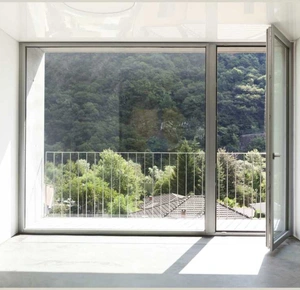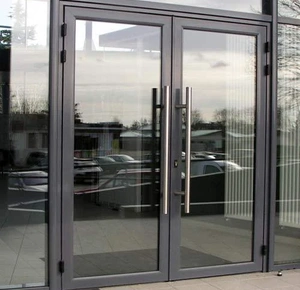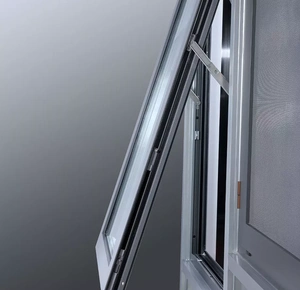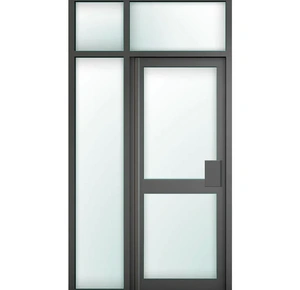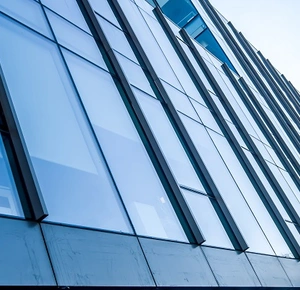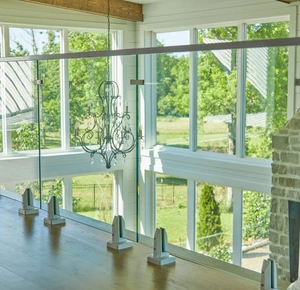Transforming Spaces: Using Aluminum Windows and Doors in Commercial Architecture
In today’s fast-paced world of commercial architecture, the demand for materials that balance functionality, durability, and aesthetics is constantly growing. Aluminum windows and doors have become a go-to solution for architects and designers looking to transform commercial spaces into modern, efficient, and visually striking environments. Their sleek design, durability, and versatility make them an ideal choice for office buildings, retail spaces, hotels, and industrial structures.
In this article, we’ll explore how aluminium windows and doors are revolutionizing commercial architecture, highlighting their benefits in terms of design, energy efficiency, sustainability, and security. Whether you're an architect, a business owner, or a property developer, you'll discover why aluminium is a top choice for modern commercial buildings.
1. Sleek, Modern Design
In commercial architecture, the aesthetic appeal of a building can make a lasting impression on clients, customers, and employees. Aluminium windows and doors provide the perfect solution for creating sleek, contemporary designs. Aluminium is strong enough to support large glass panes while maintaining thin, minimalist frames, resulting in clean lines and a streamlined look that enhances the overall appearance of the building.
Key design advantages:
- Slim profiles: Aluminium’s strength allows for thinner frames, which means more glass and less metal. This creates a seamless, open look that’s perfect for modern commercial spaces.
- Maximized natural light: Larger glass panes allow more natural light to flood the interior, creating bright, open spaces that promote a productive and welcoming atmosphere.
- Customizable finishes: Aluminium windows and doors are available in a wide range of colours and finishes, thanks to advanced powder-coating technology. This allows architects and designers to match the frames to the building’s design scheme, whether it's bold and modern or neutral and understated.
Whether you’re designing an office building with floor-to-ceiling glass or a retail space that requires an inviting entrance, aluminium windows and doors offer unparalleled design flexibility.
2. Durability and Low Maintenance
Commercial buildings endure more wear and tear than residential properties due to the high volume of foot traffic and exposure to environmental elements. Aluminium windows and doors are prized for their durability, making them ideal for the demands of commercial architecture.
Why aluminium is perfect for commercial spaces:
- Weather resistance: Aluminium is highly resistant to corrosion, rust, and weather damage, making it ideal for exterior applications in areas with harsh climates, such as high humidity or coastal regions.
- Long lifespan: Aluminium windows and doors can last for decades with minimal maintenance. Unlike wood, which may warp or rot, or steel, which can rust, aluminium maintains its structural integrity and appearance over time.
- Low maintenance: Aluminium doesn’t require regular painting or refinishing. Its powder-coated or anodized finish is resistant to fading, peeling, and scratching, reducing the need for upkeep and allowing building managers to focus on other areas of maintenance.
For commercial properties, where downtime for repairs can be costly, aluminium’s low-maintenance requirements make it an attractive option.
3. Energy Efficiency and Sustainability
With growing concerns about climate change and rising energy costs, energy efficiency has become a key consideration in commercial architecture. Aluminium windows and doors, when combined with the right glazing and thermal break technology, can dramatically improve a building’s energy performance.
Energy-efficient features of aluminium windows and doors:
- Thermal break technology: Modern aluminium frames are equipped with thermal breaks, which are insulating layers that reduce heat transfer between the inside and outside of the building. This helps maintain a comfortable indoor climate and reduces the need for excessive heating or cooling.
- Double or triple glazing: Using double or triple-glazed glass enhances insulation, keeping heat inside during the winter and out during the summer. This not only improves comfort but also lowers energy consumption, which can lead to significant cost savings for commercial property owners.
- Low-E coatings: Low-emissivity (Low-E) glass reflects heat back into the building while allowing natural light to pass through. This maximizes energy efficiency without compromising on aesthetics or functionality.
Sustainability is also a major benefit of aluminium. Aluminium is 100% recyclable, and recycling aluminium requires only 5% of the energy needed to produce new material. Choosing aluminium windows and doors for a commercial project reduces environmental impact and supports the growing trend of green building practices.
4. Enhanced Security and Safety
Security is a top priority in commercial buildings, and aluminium windows and doors offer excellent protection against unauthorized access and damage. Aluminium’s natural strength, combined with modern security features, makes it a reliable choice for securing commercial properties.
Key security benefits:
- Robust frames: Aluminium is a strong material that resists impact, making it difficult for intruders to break through windows or doors. This added strength is especially important for ground-floor applications, where security concerns are greater.
- Multi-point locking systems: Many aluminium doors come with multi-point locking mechanisms, which secure the door at multiple points along the frame. This adds an extra layer of security, making forced entry much more difficult.
- Toughened or laminated glass: For additional protection, aluminium windows can be fitted with toughened or laminated glass, which is more resistant to breakage. Laminated glass also holds together when shattered, preventing easy access into the building.
In environments where security and safety are paramount, such as banks, retail stores, or office complexes, aluminium windows and doors provide a reliable solution without sacrificing style or design.
5. Flexibility in Design and Customization
One of the greatest advantages of using aluminium in commercial architecture is its design flexibility. Aluminium is a highly versatile material that can be customized to meet the specific needs of any commercial project. Whether the goal is to create large, open spaces or incorporate unique architectural elements, aluminium can be fabricated into various shapes and sizes.
Customization options include:
- Bespoke shapes and sizes: Aluminium windows and doors can be made to fit any architectural design, from large picture windows to unique geometric shapes that give a building its distinct character.
- Variety of styles: Aluminium doors are available in many styles, including sliding, bi-fold, French, and pivot doors, allowing architects to select the best design for each space.
- Finish options: Aluminium frames come in a variety of finishes, including powder-coated, anodized, and wood-effect finishes. This allows designers to match the doors and windows to the building’s aesthetic or make them stand out as a design feature.
Aluminium’s versatility ensures that it can be tailored to suit any commercial project, no matter how complex or creative the architectural design may be.
6. Maximizing Natural Light and Space
Modern commercial architecture often focuses on creating open, light-filled spaces that promote well-being, productivity, and comfort. Aluminium windows and doors are perfect for achieving this, as their slim profiles and large glass panes allow maximum natural light to enter the building.
Benefits of maximizing natural light:
- Improved employee well-being: Studies have shown that exposure to natural light can enhance mood, increase productivity, and improve overall well-being, making aluminium windows a great choice for office spaces and other work environments.
- Energy savings: By allowing more natural light into a building, aluminium windows reduce the need for artificial lighting during the day, leading to lower energy consumption and cost savings.
- Enhanced visual appeal: Expansive windows create a sense of openness and make commercial spaces more inviting and visually appealing, which can be important for businesses looking to attract clients or customers.
The ability to incorporate large glass panels into aluminium frames without sacrificing strength or security makes aluminium windows and doors ideal for creating light-filled, spacious commercial interiors.
7. Cost-Effectiveness and Long-Term Value
While aluminium windows and doors may have a higher upfront cost compared to some other materials, their long-term value far outweighs the initial investment. Aluminium’s durability, low maintenance requirements, and energy efficiency mean that building owners will save money on repairs, replacements, and energy costs over time.
Key long-term value benefits:
- Reduced maintenance costs: Aluminium’s low-maintenance nature means fewer repairs and touch-ups, leading to lower operational costs for commercial buildings.
- Energy savings: The energy-efficient properties of aluminium windows and doors can lead to significant reductions in heating and cooling costs, offering long-term savings on utility bills.
- Increased property value: High-quality, well-designed aluminium windows and doors can enhance the market value of a commercial property, making it more attractive to potential buyers or tenants.
For commercial projects that prioritize long-term performance, aluminium windows and doors are an investment that pays off in the form of durability, efficiency, and aesthetics.
Conclusion
Aluminium windows and doors are transforming the world of commercial architecture, offering a perfect blend of functionality, durability, and style. With their sleek design, energy efficiency, low maintenance, and security features, they provide architects and designers with the flexibility to create visually stunning and high-performing commercial spaces.
Whether you're working on a new office building, retail space, or industrial complex, choosing aluminium windows and doors ensures a modern, efficient, and long-lasting solution that enhances both the aesthetics and performance of the structure. With the added benefits of customization and sustainability, aluminium is a smart choice for any commercial architecture project.
Frequently Question and Answers
How do aluminium windows and doors help with noise reduction?
Aluminium windows and doors reduce noise through double or triple glazing, acoustic glass, and thermal breaks in the frames. These features create barriers that block sound waves from entering your home.
What is acoustic glass, and how does it reduce noise?
Acoustic glass consists of two layers of glass with a polyvinyl butyral (PVB) interlayer, which absorbs and dampens sound waves. It is particularly effective at reducing low-frequency noises, like traffic or construction sounds.
Are double-glazed aluminium windows enough for noise reduction?
Double-glazed windows provide good noise reduction by adding an insulating layer between two panes of glass. However, triple glazing or acoustic glass is more effective in areas with higher noise levels.
How do thermal breaks in aluminium frames help with soundproofing?
Thermal breaks are insulating layers within the aluminium frames that reduce heat transfer. They also absorb sound vibrations, helping to prevent structure-borne noise from passing through the window or door frame.
Do I need thicker frames for better noise reduction?
Yes, thicker aluminium frames provide more mass, which helps block sound waves more effectively. Opting for thicker frames can enhance the overall soundproofing performance of your windows and doors.
Can I customize aluminium windows and doors for better noise insulation?
Absolutely. You can customize window sizes, glass types, and frame thickness to fit your specific noise reduction needs. Custom solutions allow for the best performance in high-noise areas like urban environments or near busy roads.
